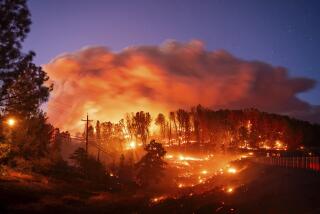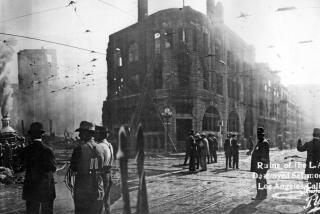Man in Arson Case Tied to L.A. Riots Acquitted : Crime: He is the first to be tried on the charge. Investigators admit they lacked a full range of physical evidence.
- Share via
The first suspect to be tried on major riot-related arson charges has been acquitted by a federal jury after investigators acknowledged in court that they were unable to collect a full range of physical evidence because of personnel shortages and a crushing caseload.
The defendant, Erik Crenshaw, a 22-year-old Fontana plumber, was one of only two of the 60 suspected arsonists charged after the spring riots to face trial in federal court, where penalties can be far higher than in the state system. He was accused of setting fire to Albee’s Appliances near Fairfax Avenue and West Pico Boulevard on April 30, the second day of rioting last spring.
The jury, a diverse group of eight women and four men, deliberated three days before returning a unanimous not guilty verdict.
Crenshaw was charged with one count of setting fire to a building used in interstate commerce and a second count of using a firearm in a crime of violence. He had faced up to 40 years in prison if convicted.
Crenshaw admitted attempting to loot the warehouse, but he denied eyewitness accounts that he had carried Molotov cocktails into the building shortly before it began burning.
Officials of the Los Angeles City Fire Department warned during the rioting that arson cases would be hard to prosecute. Many fires destroyed physical evidence, they said, and there was insufficient manpower to conduct full investigations of the thousands of arson fires reported during the civil unrest. Defense attorneys also voiced concerns that charges would be brought on insufficient evidence.
Tuesday’s acquittal appeared to reinforce all of those concerns.
“A lot of people are upset about what happened back then and want to blame somebody,” said Public Defender Drew Edwards, who represented Crenshaw. “But just because we’re in a riot-related situation, that doesn’t mean people’s rights should get suspended. The evidence wasn’t there, and in the end, the jurors did the right thing.”
Assistant U.S. Atty. Walter F. Brown Jr., who prosecuted the case, said federal authorities felt they had sufficient eyewitness testimony to convict Crenshaw without physical evidence.
“Certainly if we’d had a bottle with his fingerprint on it, that would have been additional strong evidence,” Brown said. “But we felt there was sufficient evidence to convict anyway. . . .”
Crenshaw was arrested in May after a witness reported having seen him make Molotov cocktails near Pico Boulevard and Fairfax Avenue. According to an affidavit filed in connection with the case, the witness said he saw Crenshaw and an unnamed companion carry the firebombs into Albee’s warehouse.
The affidavit said Crenshaw also was overheard threatening tenants in an apartment above the burning warehouse and discussing “the next location” with the companion.
However, arson investigators testified during the trial that they were extraordinarily shorthanded and were not able to conduct the sort of thorough search for physical clues that they might have made during non-riot periods.
There were also some contradictions in witnesses’ testimony.
While some witnesses testified that they watched Crenshaw carry bottles containing a liquid near the warehouse at the time of the fire, they disagreed in their descriptions of where he entered the building. Three witnesses testified that he had entered at an alcove; another said the alcove was locked and chained at the time of the fire.
Battalion Chief Les Hawkes, who oversees the Los Angeles Fire Department’s arson squad and helped conduct the investigation, said he was convinced that eyewitness testimony in the case was sufficient to convict Crenshaw.
“The fact of the matter is you don’t have to have physical evidence to have a case,” he said. “We had eyewitnesses, and the jury--for whatever reasons--disagreed with them. It’s nice to have both (kinds of evidence), I have to admit that, but you don’t need both.”
More to Read
Sign up for Essential California
The most important California stories and recommendations in your inbox every morning.
You may occasionally receive promotional content from the Los Angeles Times.









